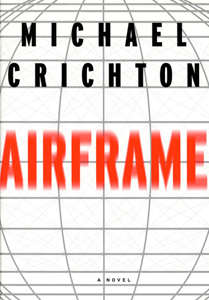“Airframe” (1996) is the last Michael Crichton novel (under his own name) that I read for the first time. In the wake of “The Lost World,” a book about airplane industry intrigue was a groaner to a teenage reader. But “Airframe” turns out to be an expert-level thriller from an author at the top of his game.
The truth can be complex
This is very much an adult novel, requiring basic knowledge of the way politics, corporations and TV news shape narratives and John Q. Public’s perception of reality. If you come in with that basic foundation, Crichton rewards you with deeper levels of intrigue, all of it graspable, and all of it believable because of his attention to detail.
A side plot – which becomes a major plot by “Airframe’s” end – is about a hotshot young “Newsline” reporter, Jennifer Malone, putting together a segment on how Norton’s N-22 plane is a deathtrap. That piece is in danger of falling through if it turns out the craft is safe, which is what our Norton-employed hero, Katherine “Casey” Singleton, aims to prove.

“Airframe” (1996)
Author: Michael Crichton
Genre: Industrial thriller/mystery
Setting: Los Angeles, 1996
Ironically, if Malone had told the story like Crichton does, it would have audiences glued to their seats. But — as her terrifying-when-disappointed producer makes clear — the revelation of the actual reason why the N-22 porpoised (rapidly dipped and rose multiple times), killing three and injuring dozens, will not play well in the “Newsline” format.
Crichton makes a reader reflect on all the news that doesn’t make it to TV – or is spun a certain way on TV – because it is complex or because it doesn’t have visual hooks.
In Casey’s shoes
A thriller novel is a different matter, thankfully. In “Airframe,” we spend most of our time with Casey, reveling in every discovery, frustrated by every dead end, and ultimately as tired as she is from the task of proving the aircraft is safe.
(There’s never much doubt it is safe, thanks to the POV we get, but proving it – by determining what really happened on Flight 545 – is another matter.)
In addition to the TV crew (fronted by a delicious stereotype of a celebrity anchor, Marty Reardon), Casey gets pressure from Norton internal political maneuvering and from the workers’ union that believes jobs will be outsourced to China. “Airframe” is a snapshot of how middle management gets it from every direction.
Still relevant
Among Crichton’s three 1990s non-SF works, “Airframe” is the most relevant today. “Rising Sun” is politically outdated and “Disclosure” – although it chronicles the still-relevant issue of workplace sexual harassment – features a lot of old tech.

Ironically, part of why “Airframe” is less dated is that the US airline industry is closely tied to the government, so competition is limited and tech advancements are relatively slow. Crichton doesn’t delve into this much; he neither praises nor criticizes the setup. Indeed, he gives a glowing account of how the N-22 is state-of-the-art and air travel is incredibly safe when compared to, say, automobile travel.
But Crichton delves into a lot of nooks and crannies about the industry – and the plane itself. One segment finds Casey scouring the aircraft for the location of a Quick Access Recorder, which could provide clues to what happened on the ill-fated flight.
In a darkened hangar, she’s pursued by thugs from the union. It’s a transparent attempt to add a scene of physical danger to a mystery yarn that doesn’t lend itself to that. This is the only part of the book that’s a little shaky. Still, it does illustrate how jobs are so central to everyone’s life – especially in America — that they can become a life-or-death proposition.
“Airframe” is masterful industrial thriller. I learned a ton about topics that wouldn’t ordinarily interest me, but which enthralled me under the keystrokes of Crichton.

